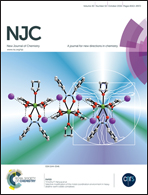Propensities to form the β-turn and β-hairpin structures of d-Pro-Gly and Aib-d-Ala containing peptides: a computational study†
Abstract
The preferences for peptides containing D-Pro-Gly or Aib-D-Ala segments to adopt β-turn and β-hairpin structures were explored using DFT methods and the implicit solvation model in CH2Cl2 and water. The populations of the preferred β-turn structures varied depending on the sequence and solvent polarity. The preferences of β-turn structures for Ac-D-Pro-Gly-NHMe were βI′ > βII′ in CH2Cl2 and βII′ > βI′ in water. The preferences for Ac-Aib-D-Ala-NHMe were βI′ in CH2Cl2 and water. β-Hairpin structures with βI′ turn motifs were the most preferred for heptapeptides containing Aib-D-Ala in CH2Cl2 and water. However, the β-hairpin structures of D-Pro-Gly-containing heptapeptides with strands composed of non-Ala residues exhibited preferences for the βII′(u) turn motif in CH2Cl2 and the βI′(u) or βII′(d) turn motif in water. Through the analysis of calculated thermodynamic properties, the sequence, strength of H-bonds, solvent polarity, and conformational flexibility appeared to interact in determining the preferred β-hairpin structure of each heptapeptide, although β-turn segments played a role in promoting the formation of β-hairpin structures and the β-hairpin propensities varied. In the heptapeptides containing D-Pro-Gly or Aib-D-Ala (hpdPG-3 or hpBdA-2, respectively), β-hairpin formation was enthalpically favored and entropically disfavored at 25 °C in water, which is consistent with experimental results for the oligopeptides with similar sequences around the β-turn segments. The propensity for β-hairpin formation was greater for hpBdA-2, whereas the decrease in entropy due to β-hairpin formation was greater for hpdPG-3. The structural preferences of β-turns and β-hairpins containing D-Pro-Gly or Aib-D-Ala segments obtained here may be useful for the design of bioactive macrocyclic peptides containing β-hairpin mimics and the design of binding epitopes for protein–protein and protein–nucleic acid recognitions.



 Please wait while we load your content...
Please wait while we load your content...